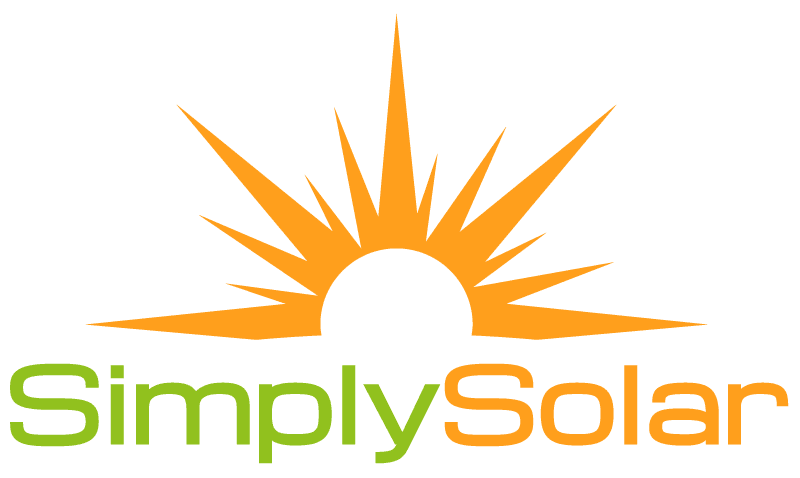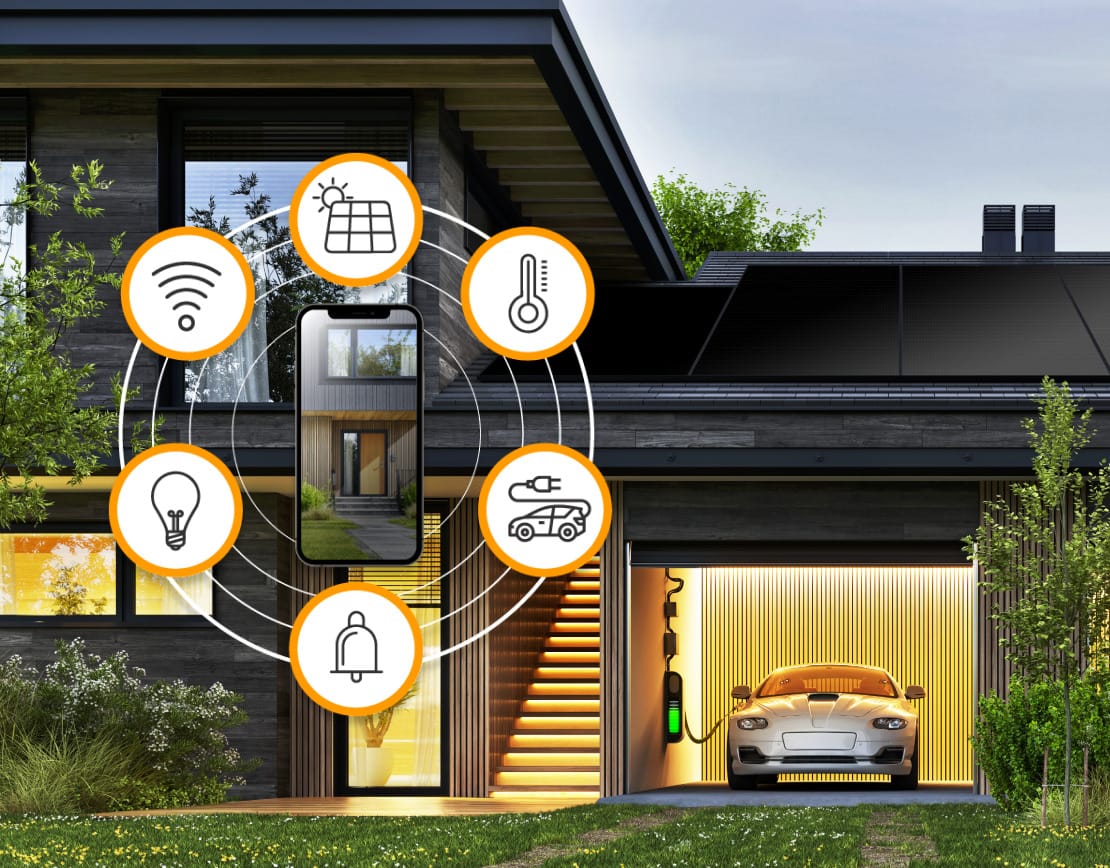One of the sun’s greatest gifts is the light that warms our planet and allows for the possibility of life. It is our good fortune then that we now have the means to convert its light into energy. Especially in recent years, the cost of channeling this energy by installing solar panels has decreased by 70%.
As a result, the number of homes relying on solar energy is only growing! Additionally, since the passing of the California Solar Mandate in 2020, all new home construction is to have solar PV systems installed, with some exceptions. This has caused an even greater interest and growth for the solar industry!
Solar energy works by using a process called the photovoltaic effect. The PV effect allows us to convert sunlight into energy you can use to powers lights, TVs, and appliances, just like electricity from the grid would.
To generate this power, you’ll need solar panel systems and all of their components, including solar panels to capture energy, inverters to convert energy into a usable format, and racking to mount your system, as well as batteries, wiring, and fusing.
While many parts of a solar panel system are the same, differences in types of panel and installation processes will affect the total cost. You’ll also want to consider factors like where you live, rebates, and available tax incentives.
In this comprehensive guide, we cover everything you need to know about the solar installation process, from the initial site visit to financing your system.
Keep reading to learn exactly what to expect when you make the switch to solar.
Types of Solar Panels
All residential solar panels use the PV effect to create energy. However, different variations among the type of panel you choose will affect the installation costs.
Grid-tied Solar Panel Systems
Most of the time, residential installation of solar panels will involve grid-tied solar panels systems.
A grid-tied system is connected to your home wiring system and the electrical grid. It uses energy from the solar panels if there is solar energy available and otherwise uses electricity from the grid when necessary.
Grid-tied systems are the least expensive type of solar power system available since you’re not relying on them to completely meet your electricity consumption - you can use energy from the grid when the solar energy isn’t enough.
A cool benefit of grid-tied solar panel systems is that if you generate excess electricity, you can sell them for credits on your electricity bill in a process known as net metering.
Over the lifetime of the system, you’ll save thousands of dollars from both the electricity saved by the panels and the profits from net metering.
Because your system would be connected to the grid, though, it’s not exempt from any issues that you would experience from a typical power outage.
You wouldn’t be able to continue using solar energy during a power outage. For that, you’d need a system with energy storage capabilities.
Grid-Tied Panel Systems With Energy Storage
This type of solar energy system is the same as the standard grid, except that it has additional energy storage in the form of solar batteries. Having solar batteries lets the system operate when solar energy is scarce.
For instance, a grid-tied solar panel without energy storage can’t use energy from the sun once it becomes dark outside. It will need to pull electricity from the grid in order to use energy at night.
With a solar battery, you can use electricity that was stored in the grid during the day, instead of relying on the grid.
Unlike a basic grid-tied system, you’ll still have power in the case of a blackout. It will have enough backup power to keep the lights on in your home, which is especially helpful if you live in an area that is no stranger to grid blackouts or energy shortages.
Because of its additional capabilities, this system costs more than installing a simple grid-tied system. The solar battery will have extra costs, too.
However, the upfront costs become worth it in the long run. California’s time-of-use plan charges higher costs for electricity during peak hours, which is in the late afternoon and evening. A solar battery will save you from pulling electricity from the grid during these times.
Off-Grid Systems
A solar-powered system doesn’t need to be connected to the grid in order to work, though. An off-grid systems functions independently, relying solely on solar power.
It uses its PV panels and solar batteries to eliminate any reliance on the electric grid within its system, having enough storage capacity on its own to power all of your home's appliances and electricity sources.
In states like California, an off-grid system is a reasonable option to consider because of the ample sunlight. With enough storage, you’ll have plenty of energy for your entire home.
However, because the system doesn’t use any electricity from the grid, it will need to be large enough both to collect and store all of the energy you need.
Because you’ll need more solar equipment, off-grid systems are significantly more expensive than grid-tied systems. While they’re the most environmentally friendly choice, off-grid systems should only be installed if you’re financially ready to make such a large commitment.
Otherwise, a grid-tied system will give you the most value for your money by lowering installation costs and giving you the assurance of having two sources of energy available.
Solar Panel Installation Process
The solar panel installation process is one that usually takes months from start to finish. By understanding the steps necessary to add a solar system to your home, you can have a better idea of the costs you can expect (more on that later).
Initial Visits
Before you sign any paperwork, an installer will come by for an initial visit to evaluate your property. They’ll look at your roof type, angle of the roof, and shading while considering the proper system size to install.
This will give you a general idea of what you can expect the process will look like before you make any commitment.
Then, when you’ve signed your solar contract (whether it’s a lease, loan, or cash purchase), it’s time for an engineer to visit your property to evaluate the status of your home.
They’ll need to make sure that your existing property is compatible with a new energy system.
The engineer will take a look at your roof and evaluate its condition to determine if its structurally able to handle solar panels. They’ll also look at your electrical panel to see if your home can provide enough amps of current to be compatible with a solar panel.
Permits and Documentation
Installing your solar panel system will require a hefty amount of paperwork. Most of it is taken care of by the installer, but it’s still wise to know what you’re signing.
If you’re installing solar panels in California, you’ll be applying for solar incentives like the ITC, local solar programs, and solar renewable energy certificates.
Aside from these documents, you’ll also need to take care of some basic paperwork during the solar installation process. Most of these documents are based on where you live.
For instance, California requires you to complete a few permits to make your home solar-ready.
These permits require that you meet certain requirements such as the following.
- Homes must comply with access, pathway, and spaced requirements satisfied in California’s Title 24 codes
- The solar zones must not contain any obstructions
- All sections of the solar zone on steep roofs must be between 90 and 300 degrees within true north
- The main electrical service panel has to have a minimum rating of 200 amps
You won’t have to worry about most of these requirements, though, as your installation team will be aware of what steps are needed to install your solar panel system safely and properly.
Preparation and Installation
After you’ve completed all of the necessary paperwork, it’s time to order the equipment you need. You’ll have already signed off on total costs before you order any equipment, so you won’t be in for any surprises.
Solar panels and inverters are the two components of your system that will affect the price the most. There will be certain brands for both, and each brand will have different durability, efficiency, and aesthetics.
If you want to have an educated discussion with your team on the best choices for you, it’s best to do some research beforehand. Take some time to learn about the best-rated solar panels on the market and microinverters vs. power optimizers.
Next, you'll schedule a day for installation. Your panels and inverters will arrive on the day of your installation, which typically happens about a month or two after you begin the paperwork.
If you start your process in the winter, it may take less time since solar companies typically aren’t as busy.
On the day of installation, your solar installer will start by evaluating your roof one last time. They’ll prep your roof by making sure tiles are properly attached, then begin attaching the electrical wiring that connects the system.
Once the wiring is complete, they’ll install the racking that supports your panels by attaching it to the roof. Panels are placed onto the racking.
The last step is to connect inverters to the panels so that the direct current energy from the sun turns into the alternating current energy within your home.
Approval and Connection
Once your grid-tied solar system is installed, you’ll need to gain approval from your city before generating power.
A representative from your town’s government will visit your home and inspect the system, making sure that the installer did the wiring correctly, mounted the panels safely, and installed the system properly.
If they deem that the panels are up to par, they’ll give you the go-ahead for grid interconnection. Someone from your utility company will come by for one final evaluation, then connect you to the grid as soon as they’re finished.
After your panels are installed, it will take a few weeks for town and utility approval. Expect about a month before your system will go live.
Solar Panel System Cost
You can expect your solar panel installation to cost anywhere between $15,000 to $25,000. However, this doesn't give you an accurate picture of the other factors that play a role in the true costs of going solar.
Over time, solar panel systems can pay for themselves. In other cases, you may sink large costs into installing a solar panel with no returns. Consider how these factors will affect the installation of a solar panel on your home.
Current Electricity Costs
How much are you spending on electricity?
If you live in California, it's probably a lot. Electricity in California comes in at almost 20 cents per kilowatt-hour. To give you some context, the average price of energy in the U.S. is about 11 cents per kilowatt-hour.
Installing a solar panel in a state like California, then, is going to be much more cost-effective than installing one in a state with inexpensive energy.
Over the lifetime of your solar panel, the thousands of dollars you end up saving on energy will offset its installation cost.
Roof Eligibility
As mentioned before, initial visits will be conducted before any contracts are signed. During these visits, you'll find out if your roof and electrical panel are equipped to handle solar panels.
Replacing your electrical panel will cost a couple of thousand dollars, but roof adjustments can reach the tens of thousands of dollars quickly.
It's important to consider the condition of your roof before you sign off on installing solar panels, as it can add a significant amount to your cost.
Sunlight Exposure
If you live in California, you get to bask in the sunshine for over 2/3 of the year. This means that you'll have significant savings from solar panels.
Past times in which you've relied on electricity from the grid can now become hours of the day that utilize nothing but solar energy. Even better, you can sell energy back to your utility company using the net metering process explained above.
In other states where sunny days aren't as frequent, it's going to take longer to pay back the costs of installing the panel with sunny days alone.
Solar Panel System & Size
Your choice to use grid-tied or off-grid systems will play a large role in the cost of your solar panel installation. Grid-tied systems are the least expensive, then grid-tied with storage, then off-grid systems as the most costly option.
The size of your solar panel system will also determine cost. If your goal is to switch to mostly solar-powered energy without giving up any of your current energy consumption, you're going to need a larger roof area and a larger system to meet your needs.
Return on Investment & Financing
Paying for a solar panel system is costly, and many households don't pay for the system in cash. Often, they'll take out a loan or a lease. These different payments methods will affect the cost of your solar system.
Taking out a solar energy loan means that you own the solar system and are responsible for any issues that arise.
You won’t be offered an energy production guarantee, but you will be able to apply for solar energy incentives, rebates, and credits. Even better, your home will go up in value.
A solar energy lease will give you the benefits of using a solar panel system without owning it. You won’t be responsible for any issues, and you’re likely to get a guarantee that a certain amount of energy will be delivered.
However, you’ll pay much more in financing costs over time, and you won’t be able to apply for incentives, rebates, or tax credits to offset these costs.
Solar Panel Longevity
The most important part of installing a solar panel is ensuring that it will stand the test of time. If you're constantly repairing it or replacing parts, your costs will always outweigh the benefits.
That's why the Simply Solar team takes a personalized approach to the installation of solar panels.
While other solar companies usually hire contractors to add solar panels to your home, we use an in-house team to perform custom installations. Our technicians won't leave until the installation is perfect.
The Federal Solar Tax Credit
A tax credit is a credit given by the government that reduces the amount of income tax you would owe.
It’s a dollar-for-dollar reduction, meaning that if you claim a tax credit of $1000, you’ll pay exactly $1000 less in income taxes. If your total tax is $1000 but you claim a $2000 earned income credit, the government will refund you $1000.
You may be eligible for a federal tax credit if you install a solar panel.
How the Federal Solar Tax Credit Works
The federal residential solar energy credit is the tax credit that can be claimed if you install a solar photovoltaic (PV) system. The tax credit will be available as a percentage of the cost of installation.
The credit becomes available to anyone who places a solar panel in service within the given tax year. There’s not a test to determine what “in service means,” but an IRS guideline is that a solar panel that’s “in service” has completed all installation.
In December 2020, Congress extended the ITC, also known as the Energy Investment Tax Credit. In California, this means that you would have been able to expect to receive a 26% tax credit for systems installed in 2020-2022. Systems installed in 2023 would then receive a 22% tax credit.
However, recent changes brought on by the Inflation Reduction Act have revitalized this tax credit in an exciting way - instead of tapering off in the next two years, the federal tax credit has been increased to 30% and extended for 10 years! This bill has created exciting new opportunities in the renewable energy space, allowing for residents to claim additional tax credits for electric vehicles and energy storage systems on top of what they can claim for a solar installation.
Who is Eligible for the Solar Tax Credit
In order to receive the original tax credit, you have to meet a few eligibility requirements.
First, your solar PV system had to have been installed between January 1, 2006, and December 31, 2023. The newly passed IR Act has extended this timeframe for the next ten years, and includes systems installed in the year it was passed, 2022.
Your solar PV system must be located at your primary or secondary residence within the United States. The law also grants the tax credit if you use the system for an off-site community solar project if the electricity consumed does not exceed your residence’s electricity generated.
You much purchase the system either by cash or via financing.
Lastly, the solar PV system must be new or is being used for the first time. The credit counts toward the original installation.
Expenses Included
The tax credit includes most of the expenses associated with installing your solar panel system.
- Cost of Solar PV panels to power an attic fan
- Contractor labor costs for onsite prep, assembly, installation, permitting fees, inspection costs, and developer fees
- Wiring, inverters, and mounting equipment used to balance the system
- Energy storage devices that are charged by the associated solar PV panels
- Sales taxes
Make sure to track these expenses so that you can claim your tax credit!
Federal Vs. State Credit
In some states, you can earn additional credits for installing a solar system, and they won't affect your federal tax credit claim.
However, the state of California does not offer any state credits for installing solar panel systems. Your best option is to take advantage of the 26% federal tax credit.
Other Incentives that Affect the Credit
Your electric utility company may give you an incentive to install solar by providing you with a rebate from the installation. In these cases, you’d subtract the rebate from the total cost of panel installation before claiming your tax credit.
For instance, say your solar panel was installed on September 1, 2021, for $20,000. Your utility gave you $1000 as a rebate.
To calculate your tax credit, you’d use the following formula.
0.30 * ($20,000 - $1,000) = $5,700
When all is said and done, you’d receive $5700 back.
Claiming the Tax Credit
To receive the tax credit, complete the IRS Form 5695 and attach it to your federal tax return (Form 1040 or Form 1040NR). You can find instructions and information about the form here.
Make sure to consult with a tax professional before filling out the form to ensure that you are both eligible and completing all of the necessary steps.
Explore the Benefits of Solar Panel Systems
Installing solar panels on your home is the best way to save money in the long term while helping the environment.
With over 20 years of experience, the Simply Solar team is known for its high-quality service, installing solar panels that will last for years to come. We also offer solar solutions that are tailored for builders and new home construction.
Get in touch for a free estimate. Our in-house team is excited to work with you!



